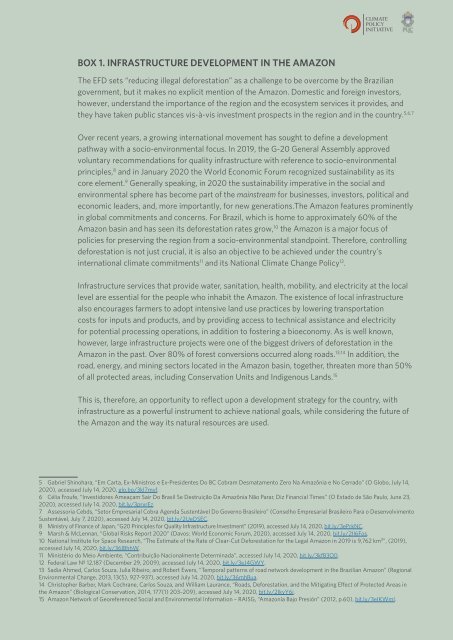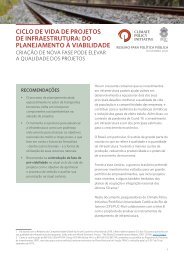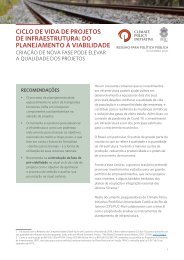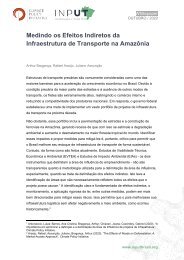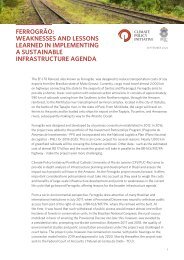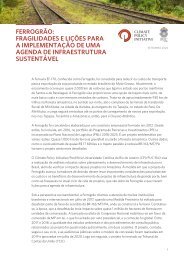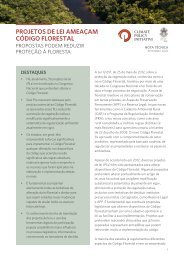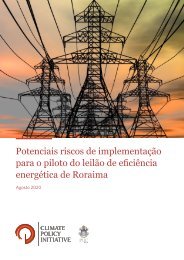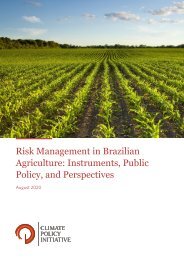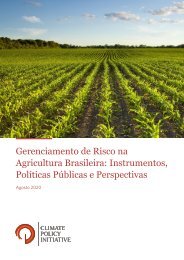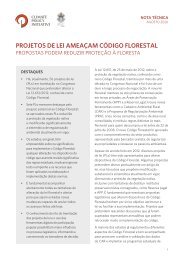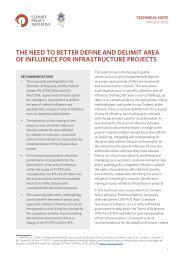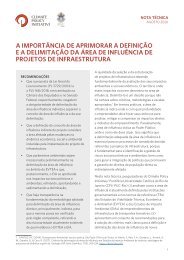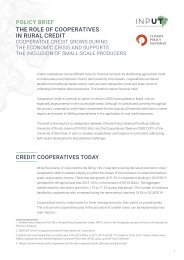Brazil’s Infrastructure Project Life Cycles: from Planning to Viability. Creation of a New Phase May Increase Project Quality
Create successful ePaper yourself
Turn your PDF publications into a flip-book with our unique Google optimized e-Paper software.
BOX 1. INFRASTRUCTURE DEVELOPMENT IN THE AMAZON<br />
The EFD sets “reducing illegal deforestation” as a challenge <strong>to</strong> be overcome by the Brazilian<br />
government, but it makes no explicit mention <strong>of</strong> the Amazon. Domestic and foreign inves<strong>to</strong>rs,<br />
however, understand the importance <strong>of</strong> the region and the ecosystem services it provides, and<br />
they have taken public stances vis-à-vis investment prospects in the region and in the country. 5,6,7<br />
Over recent years, a growing international movement has sought <strong>to</strong> define a development<br />
pathway with a socio-environmental focus. In 2019, the G-20 General Assembly approved<br />
voluntary recommendations for quality infrastructure with reference <strong>to</strong> socio-environmental<br />
principles, 8 and in January 2020 the World Economic Forum recognized sustainability as its<br />
core element. 9 Generally speaking, in 2020 the sustainability imperative in the social and<br />
environmental sphere has become part <strong>of</strong> the mainstream for businesses, inves<strong>to</strong>rs, political and<br />
economic leaders, and, more importantly, for new generations.The Amazon features prominently<br />
in global commitments and concerns. For Brazil, which is home <strong>to</strong> approximately 60% <strong>of</strong> the<br />
Amazon basin and has seen its deforestation rates grow, 10 the Amazon is a major focus <strong>of</strong><br />
policies for preserving the region <strong>from</strong> a socio-environmental standpoint. Therefore, controlling<br />
deforestation is not just crucial, it is also an objective <strong>to</strong> be achieved under the country’s<br />
international climate commitments 11 and its National Climate Change Policy 12 .<br />
<strong>Infrastructure</strong> services that provide water, sanitation, health, mobility, and electricity at the local<br />
level are essential for the people who inhabit the Amazon. The existence <strong>of</strong> local infrastructure<br />
also encourages farmers <strong>to</strong> adopt intensive land use practices by lowering transportation<br />
costs for inputs and products, and by providing access <strong>to</strong> technical assistance and electricity<br />
for potential processing operations, in addition <strong>to</strong> fostering a bioeconomy. As is well known,<br />
however, large infrastructure projects were one <strong>of</strong> the biggest drivers <strong>of</strong> deforestation in the<br />
Amazon in the past. Over 80% <strong>of</strong> forest conversions occurred along roads. 13,14 In addition, the<br />
road, energy, and mining sec<strong>to</strong>rs located in the Amazon basin, <strong>to</strong>gether, threaten more than 50%<br />
<strong>of</strong> all protected areas, including Conservation Units and Indigenous Lands. 15<br />
This is, therefore, an opportunity <strong>to</strong> reflect upon a development strategy for the country, with<br />
infrastructure as a powerful instrument <strong>to</strong> achieve national goals, while considering the future <strong>of</strong><br />
the Amazon and the way its natural resources are used.<br />
5 Gabriel Shinohara, “Em Carta, Ex-Ministros e Ex-Presidentes Do BC Cobram Desmatamen<strong>to</strong> Zero Na Amazônia e No Cerrado” (O Globo, July 14,<br />
2020), accessed July 14, 2020, glo.bo/3kl7mvf.<br />
6 Célia Froufe, “Investidores Ameaçam Sair Do Brasil Se Destruição Da Amazônia Não Parar, Diz Financial Times” (O Estado de São Paulo, June 23,<br />
2020), accessed July 14, 2020, bit.ly/3prvrEz.<br />
7 Assessoria Cebds, “Se<strong>to</strong>r Empresarial Cobra Agenda Sustentável Do Governo Brasileiro” (Conselho Empresarial Brasileiro Para o Desenvolvimen<strong>to</strong><br />
Sustentável, July 7, 2020), accessed July 14, 2020, bit.ly/2UeDSEC.<br />
8 Ministry <strong>of</strong> Finance <strong>of</strong> Japan, “G20 Principles for <strong>Quality</strong> <strong>Infrastructure</strong> Investment” (2019), accessed July 14, 2020, bit.ly/3ePrkNC.<br />
9 Marsh & McLennan, “Global Risks Report 2020” (Davos: World Economic Forum, 2020), accessed July 14, 2020, bit.ly/2Il6Fos.<br />
10 National Institute for Space Research, “The Estimate <strong>of</strong> the Rate <strong>of</strong> Clear-Cut Deforestation for the Legal Amazon in 2019 is 9,762 km²”, (2019),<br />
accessed July 14, 2020, bit.ly/36lBhhW.<br />
11 Ministério do Meio Ambiente, “Contribuição Nacionalmente Determinada”, accessed July 14, 2020, bit.ly/3kfB3O0.<br />
12 Federal Law Nº 12,187 (December 29, 2009), accessed July 14, 2020, bit.ly/3eJ4GWY.<br />
13 Sadia Ahmed, Carlos Souza, Julia Ribeiro, and Robert Ewers, “Temporal patterns <strong>of</strong> road network development in the Brazilian Amazon” (Regional<br />
Environmental Change, 2013, 13(5), 927-937), accessed July 14, 2020, bit.ly/36mhBua.<br />
14 Chris<strong>to</strong>pher Barber, Mark Cochrane, Carlos Souza, and William Laurance, “Roads, Deforestation, and the Mitigating Effect <strong>of</strong> Protected Areas in<br />
the Amazon” (Biological Conservation, 2014, 177(1) 203–209), accessed July 14, 2020, bit.ly/2IkyY6i.<br />
15 Amazon Network <strong>of</strong> Georeferenced Social and Environmental Information – RAISG, “Amazonía Bajo Presión” (2012, p.60), bit.ly/3eIKWml.<br />
4


